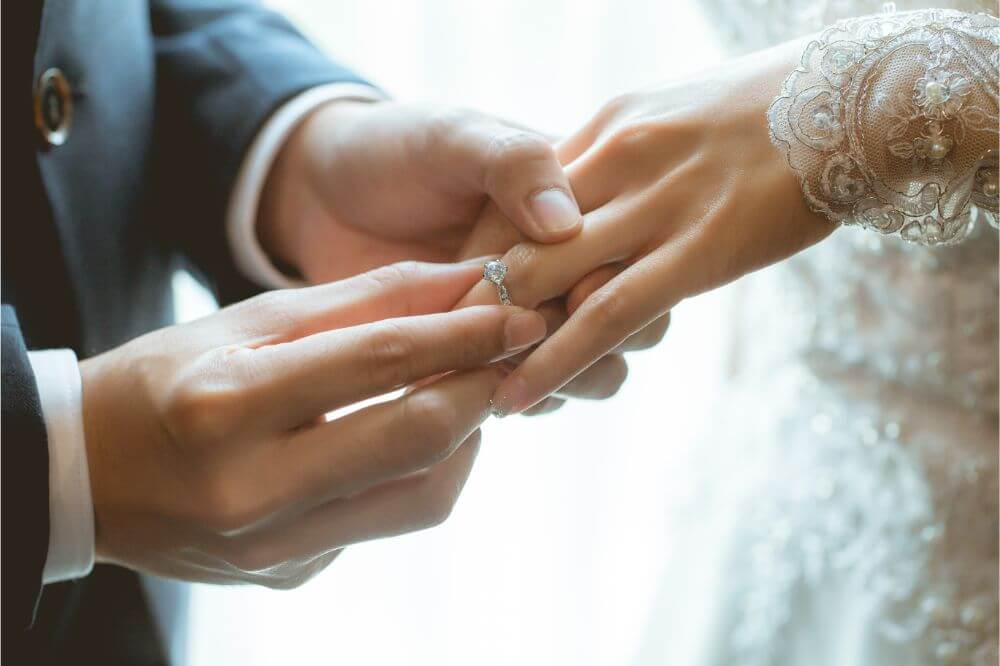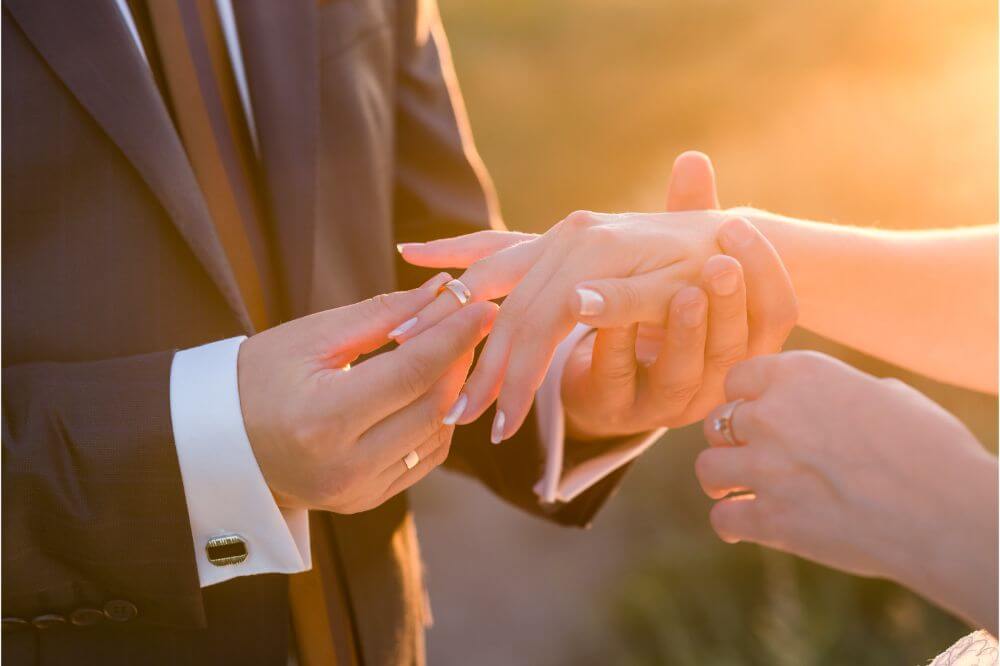For decades, it seemed like diamond engagement rings, and gold wedding bands were the norm, and our grandparent’s generation didn’t consider alternatives. Today, more couples are choosing unusual stones and settings, tattoos, smart rings, and other creative interpretations of the symbolism of marriage. In fact, the classic stones and bands of wedding rings are a relatively modern invention and remain open to interpretation. Let’s look at the history of diamond rings and marriage.
The History of Engagement Rings
The origins of today’s engagement ring traditions and uses go back to ancient times. It is speculated that engagement rings began in ancient Egypt, but it was first documented in ancient Rome. In ancient Rome and Greece, a woman was given a gold ring as part of the betrothal process. In ancient times, as today, the ring had several important meanings:
- The circular shape of the ring symbolized eternity, a bond or an oath that lasts a lifetime
- The ring was made of precious metal and was high in value, signifying deep commitment and acting as a form of insurance for the bride if the marriage should be called off
- The ring was a visible symbol of relationship status, indicating to other people that the person was in a committed relationship and intended to marry
In the 7th and 8th centuries, the use of engagement rings was formalized differently by the Catholic Church and the Visigoth Code. Then, exchanging rings was required to announce the intention to marry, preventing secret marriages, and also used as a form of a pledge, preventing people from calling off engagements after rings were exchanged.
The first documented use of a diamond engagement ring was in 1477, in the imperial court of Vienna, and diamond engagement rings became increasingly popular among the upper classes.
In 1866, diamonds were discovered in South Africa, and the subsequent exporting and availability of diamonds made diamond engagement rings more affordable and accessible for the lower classes.
After WWI and the Great Depression in the US, the popularity of diamond engagement rings was at an all-time low. The De Beers diamond cartel sought to increase sales in the 1930s and 1940s as the economy recovered and introduced the slogan “a diamond is forever” in 1947. As a result, the sale of diamonds in the US grew from just $23 million in 1939 to over $2 billion in 1979.
Despite thousands of variations of engagement traditions over the centuries and around the world, an engagement ring today means almost the same thing it meant in the 2nd century BC: It symbolizes love and commitment, reinforced by the real economic value of the ring and visible for the world to see.
How Did Wedding Rings Evolve?
While the traditions of giving the bride an engagement ring date back to ancient times, the exchange of rings between the spouses at the wedding ceremony originated in the Christian rituals of the Middle Ages.
As the church became more deeply involved in licensing and overseeing marriage, and as the concept of monogamy and fidelity was extended to both partners, the modern wedding ring became more common. The bride and groom would exchange rings, and the groom would wear a wedding band, while the bride wore both her engagement ring and her wedding band.
In the Middle Ages, gimmel rings, an early form of puzzle ring, became a popular part of the wedding tradition. A gimmel ring is a ring with two or three (or more) bands that all link together to form a single complete ring and probably originated in the Middle East. In 16th century Europe, an engaged couple would wear one band of the ring and then join them at the wedding ceremony.
A third band could be worn by a witness to the betrothal, who would then contribute their part of the ring to the completed ring at the wedding. In 1525, Martin Luther married Catherine Bora using a gimmel ring inscribed with the words “whom God has joined, let no man put asunder.”
The tradition of both bride and groom wearing a wedding ring after the ceremony was common in Europe by the 1800s and became a tradition in the US in the 20th century.
When Did Engagement Rings and Wedding Rings Become Two Separate Rings?
Historically, only one ring (the engagement ring) was given to the bride. In many traditions, she might change the hand she wore it on after marriage, but often it was simply the married woman who wore a ring.
In the Middle Ages, it became more common for couples to exchange rings as a sign of love and commitment to each other, with both men and women wearing a ring. For example, they might exchange one kind of ring during the engagement (a puzzle ring or a ring with a sentiment or commitment engraved in it) and then join the rings at the wedding ceremony, or a silver ring might be traded for a gold one.
When Did Women Start Wearing Diamond Wedding Rings?
Women’s engagement and wedding rings were always made of precious metals and high in value because they signified commitment and were a form of insurance for a woman if her groom called off the marriage.
The idea of a precious metal ring has always indicated faithfulness and commitment, and gemstones were typical adornments, especially among the upper classes.
The diamond wedding ring became iconic over time, as the De Beers cartel marketed diamonds’ clarity, hardness, and durability as a symbol of enduring love and lifelong commitment. As a result, diamond wedding rings became part of American culture in the 1940s and 50s and remain so today.
When Did Men Start Wearing Wedding Rings?
Men did not start wearing wedding rings every day until relatively recently in history. For men engaged in manual labor, wearing a ring made of precious metal daily was considered impractical.
Only the upper classes regularly wore jewelry, including signet rings and other signs of rank and office. During WWI, some men wore rings to remember their wives and families at home.
Over time, these rings came to represent responsibility and commitment, and they became commonplace for men in the 1950s.
What Does a Wedding Ring Symbolize?
A wedding ring symbolizes many things to many people. Generally speaking, a diamond wedding ring has these meanings and symbolism:
First, Eternity
A ring shape has no beginning or end, so it symbolizes eternity.
Commitment
A wedding ring is made of precious metals, so its monetary value indicates commitment, investment, and the value you place on the relationship.
Engagement and wedding rings have been made of yellow gold or white gold since ancient times since gold symbolizes wealth, purity, radiance, and perfection.
Faithfulness
Diamonds have a special symbolism in wedding and engagement rings since they are the hardest and strongest gemstones but also exceptionally clear and bright. They symbolize pure, eternal, enduring love.
Pride
Wearing a wedding ring indicates that you are proud of your partner and relationship and want the world to know how deeply you love and are loved.
Related Questions
Why is the wedding band circular?
The wedding band is circular because it fits on a finger and symbolizes continuity and eternity.
Why do we give diamonds as engagement rings? Why not other types of stones?
We give diamonds as engagement rings because diamonds have been marketed specifically for engagements for decades.
While diamonds symbolize durability and purity, other stones may have symbolism that is just as important and meaningful to you. For example, rubies symbolize love and passion, while sapphires symbolize good fortune and wisdom.
How do you care for a wedding ring?
A: To care for an engagement or wedding ring, clean your wedding ring regularly with warm soapy water and a soft brush, gently removing surface dirt and grime.
Schedule a yearly appointment with a jeweler to have the ring deep cleaned and inspected, ensuring the prongs are tight and the ring remains in good condition. Consider leaving your ring home during risky activities like high-intensity sports or a day at the beach.
Conclusion
Diamond rings symbolize marriage because these traditions have evolved over millennia. Some of the symbolism of the marriage proposal and the wedding day is extremely old and deeply part of western culture. Some of these traditions are newer, learned from our parents and grandparents.
And some of it is smart marketing. Today, couples can choose the wedding ring traditions and types that are most important and meaningful for them and make their own traditions.

